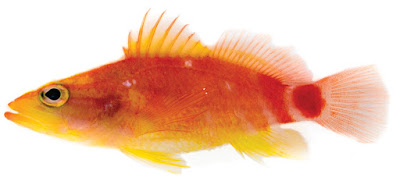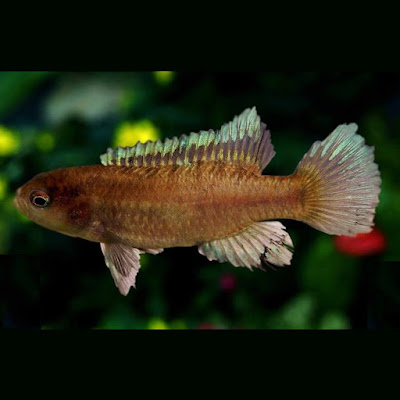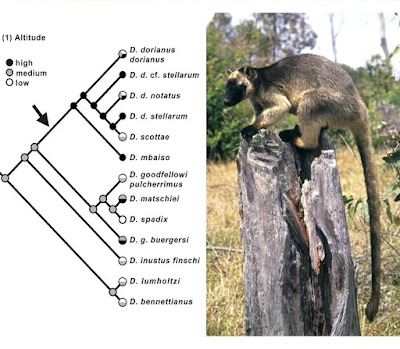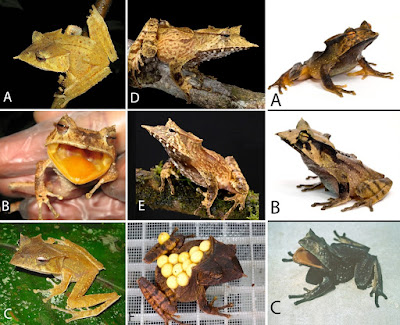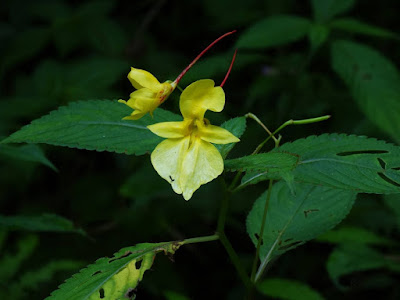[Most Recent Entries] [Calendar View]
Thursday, June 7th, 2018
| Time | Event | ||||
| 1:40a | [Ichthyology • 2018] Plectranthias ahiahiata • A New Species of Perchlet (Serranidae, Anthiadinae) from A Mesophotic Ecosystem at Rapa Nui (Easter Island)
Abstract A new species of the perchlet genus Plectranthias is herein described from a single specimen found at Rapa Nui (Easter Island) in the South Pacific. Plectranthias ahiahiata sp. n. was collected at a depth of 83 m in a mesophotic coral ecosystem at Rapa Nui. The main difference between Plectranthias ahiahiata and other members of the genus is higher fin-ray counts (X, 18 dorsal; 18 pectoral) and its distinctive coloration. Compared to the three other known eastern South Pacific species, P. ahiahiata has more dorsal-fin rays, more pectoral-fin rays, fewer tubed lateral-line scales, fewer gill rakers, a longer head relative to SL, a very short first dorsal spine relative to SL, and a short third anal spine relative to SL. Plectranthias ahiahiata is distinguished from western Pacific species, by having more dorsal- and pectoral-fin rays. The closest relative based on genetic divergence (with 12.3% uncorrected divergence in the mitochondrial COI gene) is Plectranthias winniensis, a widely distributed species, suggesting important links between Rapa Nui and western Pacific islands. This new species adds to the high endemism of the Rapa Nui ichthyofauna, and is further evidence of the importance of mesophotic reefs as unique communities. Keywords: endemism, ichthyology, reef fish, South Pacific, taxonomy
Plectranthias ahiahiata sp. n. Sunset perchlet Type locality: Hanga Piko, Rapa Nui (Easter Island), Chile. Diagnosis: Plectranthias ahiahiata differs from all of its congeners by the following combination of characters: dorsal rays X, 18; pectoral rays 18; longest dorsal spine the fourth; LL continuous and complete with 31 tubed scales; circumpeduncular scales 16; head length 43.3% SL; first dorsal spine 4.5% SL; third anal spine 13.7% SL; gill rakers 6+11; and in coloration: overall orange-red in color, with predominantly yellow snout, dorsal, pelvic and anal fins, a brilliant red spot outlined in white on the caudal peduncle, and four white spots on each side, following the contour of the lateral line. Etymology: Plectranthias ahiahiata is given a Rapa Nui name; the phrase ahiahi-ata means “the last moments of light before nightfall.” The species was given this name because the colors of the fish remind us of the beautiful Rapa Nui sunsets. To be treated as a noun in apposition. Distribution and habitat: Plectranthias ahiahiata is currently only known to occur at Rapa Nui (Easter Island). This fish was collected with hand nets at a depth of 83 m in a rocky patch reef surrounded by a large sandy area, and transported to the surface alive in a perforated plastic jar. Bart Shepherd, Tyler Phelps, Hudson T. Pinheiro, Alejandro Pérez-Matus and Luiz A. Rocha. 2018. Plectranthias ahiahiata, A New Species of Perchlet from A Mesophotic Ecosystem at Rapa Nui (Easter Island) (Teleostei, Serranidae, Anthiadinae). ZooKeys. 762: 105-116. DOI: 10.3897/zookeys.762.24618 | ||||
| 2:02a | [Ichthyology • 2018] Dario neela • A New Species of Badid Fish (Percomorpha: Badidae) from the Western Ghats of India
Abstract Dario neela, is described from a small tributary stream of the Kabini River in northern Kerala, India. It can be distinguished from congeners by the male colouration in life, which shows wide rims of iridescent blue in all median fins and the pelvic fin. It is further distinguished from all species of Dario, except D. urops by the number of abdominal vertebrae (14 vs. 11–13), and from all Dario species except D. urops and D. huli by the presence of a conspicuous black blotch on the caudal-fin base. Dario neela is distinguished from D. urops by the absence of the horizontal suborbital stripe and presence of a series of up to eight black bars on the body; and from D. huli by 27–28 vertebrae and 27 scales in a lateral row and the absence of teeth from hypobranchial 3. Dario neela is genetically divergent from both Western Ghats congeners in the mitochondrial CO1 gene, showing an uncorrected p-distance of 5.9% with D. urops and 13.1% to D. huli. Keywords: Pisces, taxonomy, freshwater fishes, Western Ghats–Sri Lanka biodiversity hotspot
Dario neela, new species Etymology. The species name neela is derived from the Malayalam word mnoe, ‘Nīla’, for blue and alludes to the striking iridescent blue colour of males. A noun in apposition. .... Ralf Britz, V. K. Anoop and Neelesh Dahanukar. 2018. Dario neela, A New Species of Badid Fish from the Western Ghats of India (Teleostei: Percomorpha: Badidae). Zootaxa. 4429(1); 141–148. DOI: 10.11646/zootaxa.4429.1.6 | ||||
| 2:39a | [Mammalogy • 2018] Phylogenetic Analysis of the Tree-kangaroos (Dendrolagus) Reveals Multiple Divergent Lineages within New Guinea
Highlights • DNA sequence data obtained from 14 of the 17 tree-kangaroo subspecies. • Paraphyletic long-footed and monophyletic short-footed groups were identified. • Six major genetic lineages were present, one in Australia and five in New Guinea. • Episodes of diversification occurred during the late Miocene and Plio-Pleistocene. • Species-level divergences within current taxa necessitate taxonomic adjustments. Abstract Amongst the Australasian kangaroos and wallabies (Macropodidae) one anomalous genus, the tree-kangaroos, Dendrolagus, has secondarily returned to arboreality. Modern tree-kangaroos are confined to the wet tropical forests of north Queensland, Australia (2 species) and New Guinea (8 species). Due to their behavior, distribution and habitat most species are poorly known and our understanding of the evolutionary history and systematics of the genus is limited and controversial. We obtained tissue samples from 36 individual Dendrolagus including representatives from 14 of the 17 currently recognised or proposed subspecies and generated DNA sequence data from 3 mitochondrial (3116 bp) and 5 nuclear (4097 bp) loci. Phylogenetic analysis of these multi-locus data resolved long-standing questions regarding inter-relationships within Dendrolagus. The presence of a paraphyletic ancestral long-footed and derived monophyletic short-footed group was confirmed. Six major lineages were identified: one in Australia (D. lumholtzi, D. bennettianus) and five in New Guinea (D. inustus, D. ursinus, a Goodfellow’s group, D. mbaiso and a Doria’s group). Two major episodes of diversification within Dendrolagus were identified: the first during the late Miocene/early Pliocene associated with orogenic processes in New Guinea and the second mostly during the early Pleistocene associated with the intensification of climatic cycling. All sampled subspecies showed high levels of genetic divergence and currently recognized species within both the Doria’s and Goodfellow’s groups were paraphyletic indicating that adjustments to current taxonomy are warranted. Keywords: Marsupialia; evolution; biogeography; ancestral state; morphology
.... Thus we recommend the recognition of 13 previously described taxa as species within Dendrolagus, two in Australia (lumholtzi, bennettianus) and 11 in New Guinea (inustus, ursinus, mbaiso, dorianus, notatus, stellarum, scottae, spadix, matschiei, pulcherrimus, goodfellowi). However, further changes to Dendrolagus taxonomy may occur as the result of ongoing studies and the addition of currently unsampled taxa. In the future we aim to utilize museum specimens to increase sample number and geographic coverage, as well as utilizing genomic approaches (e.g. Bi et al., 2013; Mason et al., 2011; Rowe et al., 2011) to increase the data available to resolve relationships and elucidate evolutionary history. Mark D.B. Eldridge, Sally Potter, Kristofer M. Helgen, Martua H. Sinaga, Ken P. Aplin, Tim F. Flannery and Rebecca N. Johnson. 2018. Phylogenetic Analysis of the Tree-kangaroos (Dendrolagus) Reveals Multiple Divergent Lineages within New Guinea. Molecular Phylogenetics and Evolution. In Press. DOI: 10.1016/j.ympev.2018.05.030 Conservation genetics of tree-kangaroos | ||||
| 4:18a | [Herpetology • 2018] Hemiphractus elioti & H. kaylockae • A Taxonomic Review of the Genus Hemiphractus (Anura: Hemiphractidae) in Panama: Description of Two New Species, Resurrection of Hemiphractus panamensis (Stejneger, 1917), and Discussion of H. fasci
Abstract We reviewed the taxonomic status of populations of frogs in the genus Hemiphractus in Panama, which have all been referred to Hemiphractus fasciatus Peters, 1862 for over 40 years. Although relatively few specimens have been collected, mostly juveniles, it is clear that these frogs inhabit three separate upland regions of the country: The Cordillera de Talamanca in western Panama, the Chagres Highlands and Cordillera de San Blas in central Panama, and the Serranía de Pirre in the far eastern portion of the country. In accordance with previously published molecular data, we identified distinctive features of the skulls of frogs representing these three allopatric populations and herein revalidate H. panamensis (Stejneger, 1917), describe the new species Hemiphractus elioti sp. nov. from the Cordillera de Talamanca, and the new species Hemiphractus kaylockae sp. nov. from the Serranía de Pirre. We also propose that the taxon H. fasciatus is a South American species not occurring in Panama. Keywords: Amphibia, Colombia, Ecuador, Hemiphractus elioti, Hemiphractus kaylockae, taxonomy Hemiphractus elioti new species Hemiphractus panamensis Duellman 1970 [in part; for reference to specimens from western Panama. Hemiphractus fasciatus Trueb 1974 [in part; for reference to specimens from western Panama]; Duellman 2001 [in part; for reference to specimens from western Panama]; Crawford et al. 2012 [in part, for samples from Río Blanco and El Copé, Prov. Coclé, and Altos de Maria, Prov. Panamá, Panamá]; Castroviejo-Fisher et al. 2015 [in part; for sample from El Copé Prov. Coclé, Panamá]; Köhler 2011 [fig. 467; in part, for map showing isolated populations in western Panama]. Diagnosis. Hemiphractus elioti may be distinguished from all species of Hemiphractus except H. fasciatus, H. kaylockae, H. panamensis, and H. scutatus by not having a postorbital indentation. Hemiphractus elioti may be distinguished from H. scutatus, an Amazonian species not occurring in Panama, by its smaller size (maximum SVL in males 52.5 mm vs. 57.4 mm in H. scutatus; females 64.7 mm vs. 80.5 mm in H. scutatus; data for H. scutatus from Trueb 1974), and by having small expanded pads on the fingers and toes (absent in H. scutatus). Hemiphractus elioti differs from H. fasciatus, H. kaylockae, and H. panamensis by having neopalatine odontoids in contact with vomerine teeth at the center of the palatal region (narrowly separated in H. kaylockae vs. widely separated in both H. panamensis and H. fasciatus; condition unknown in H. scutatus; Fig. 6). Hemiphractus elioti further differs from H. panamensis and H. fasciatus by having approximately seven vomerine odontoids (vs. approximately two; condition unknown in H. scutatus; Fig. 6). Hemiphractus elioti may be distinguished from H. kaylockae by having straight margin of the lateral margins of the paraoccipital horns (with distinct indentation, forming an angular margin in H. kaylockae; Fig. 2); supraorbital ridges absent (evident, distinct in H. fasciatus, weakly developed in H. panamensis; Figs. 2, 9); canthal ridges usually absent or indistinct (evident, distinct in H. fasciatus, H. kaylockae, and slightly developed in H. panamensis; Figs. 2, 9). Hemiphractus elioti has a subtemporal fenestra very small in males, approximately one-half of orbit in females, whereas the fenestrae are approximately one-third diameter of the orbit in both males and females of H. kaylockae (Fig. 2), approximately ½ diameter of the orbit of females in H. fasciatus (Fig. 9; males unknown), very large, approximately 1.5 times size of orbit, in females of H. panamensis (Fig. 9; males unknown); lateral margins of the quadratojugals extend to level of the lateral tips of, or very slightly beyond, the paraoccipital horns in dorsal view (extending far beyond the lateral tips of the paraoccipital horns in H. panamensis; Figs. 2, 9). .... Etymology. Edgardo Griffith and Heidi Ross have greatly contributed to the knowledge base of the natural history, reproductive biology, and conservation of Panamanian amphibians, including Hemiphractus. We are proud to acknowledge the efforts of our friends and colleagues by naming this new species of Hemiphractus in honor of their son, Eliot. The specific epithet is the singular genitive case of the name Eliot. Hemiphractus kaylockae new species Hemiphractus panamensis Duellman 1970 [in part; for reference to specimens from eastern Prov. Darién, Panamá. Hemiphractus fasciatus Trueb 1974 [in part; for reference to specimens from eastern Prov. Darién, Panamá]; Duellman 2001 [in part; for reference to specimens from eastern Prov. Darién, Panamá]; Crawford et al. 2012 and Castroviejo-Fisher et al. 2015 [in part, for samples from Cana, Prov. Darién, Panamá]; Köhler 2011 [in part; for map showing isolated populations in extreme eastern Panama]. Diagnosis. Hemiphractus kaylockae may be distinguished from all species of Hemiphractus except H. elioti, H. fasciatus, H. panamensis and H. scutatus by not having a postorbital indentation (Fig. 2). Hemiphractus kaylockae may be distinguished from H. scutatus, an Amazonian species not occurring in Panama, by its smaller size (maximum SVL in males 52.5 mm vs. 57.4 mm in H. scutatus; females 64.7 mm vs. 80.5 mm in H. scutatus; data for H. scutatus from Trueb, 1974), and by having small expanded pads on the fingers and toes (absent in H. scutatus). Hemiphractus kaylockae differs from H. elioti by having neopalatine and vomerine odontoids narrowly separated (in contact in H. elioti; condition unknown in H. scutatus), whereas these rows of odontoids are widely separated in H. panamensis and H. fasciatus (Fig. 6). Hemiphractus kaylockae further differs from H. panamensis and H. fasciatus by having approximately seven vomerine odontoids (vs. approximately two in both H. panamensis and H. fasciatus). Hemiphractus kaylockae may be distinguished from H. elioti, H. fasciatus, and H. panamensis by having a distinct indentation on the paraoccipital horms, forming an angular margin of the paraoccipital horns (Figs. 2, 9); supraorbital ridges absent (evident, distinct in H. fasciatus and weakly developed in H. panamensis; Figs. 2, 9); canthal ridges evident, distinct (absent or weakly developed in H. elioti; Fig. 2). Hemiphractus kaylockae has a subtemporal fenestra approximately one-third diameter of the orbit in both males and females, approximately one-half diameter of orbit in females in H. elioti (very small in males; Fig. 2), approximately onehalf diameter of the orbit in females of H. fasciatus (Fig. 9; males unknown), very large, approximately 1.5 x size of orbit, in females of H. panamensis (Fig. 9; males unknown); lateral margins of the quadratojugals extend to level of lateral tips of, or slightly less than, beyond the paraoccipital horns in dorsal view (extending far beyond the profile of the paraoccipital horns in H. panamensis; Figs. 2, 9). Etymology. This species is named in honor and memory of Julia Kaylock. She was a colleague and friend, beloved by many, who was passionate about the conservation of the world’s biodiversity, especially that of amphibians. She spent the latter part of her life working tirelessly to improve and document husbandry techniques for threatened Panamanian amphibians (e.g., Hill et al. 2012) maintained in ex situ facilities. She lost a lifelong battle with Type I Diabetes at the age of 28 on 12 June 2009. We graciously acknowledge her passion for amphibian conservation in the naming of this species of Hemiphractus. The specific epithet is the singular genitive case of the name Kaylock. Hemiphractus panamensis Cerathyla panamensis Stejneger 1917. Holotype: USNM 55320. Type locality: Signal Loma (Loma Peak) on the north coast of Panama, three miles [4.8 km] south of Santa Isabel, Prov. Colón, Panama. Hemiphractus fasciatus Trueb 1974 [in part; for reference to specimens from Chagres Highlands, Panama]; Duellman, 2001[in part; for reference to specimens from Chagres Highlands, Panama]; Crawford et al. 2012 [in part, for samples from Cerro Brewster, Prov. Panama, Panama]; Castroviejo-Fisher et al. 2015 [in part, for samples from Cerro Bruja and Cerro Brewster, Prov. Panama, Panama]; Köhler, 2011 [figs. 472, 473; in part; for map showing isolated populations in the HEMIPHRACTUS OF PANAMA Zootaxa 4429 (3) © 2018 Magnolia Press · 507 Chagres Highlands, Panama]. Robert L. Hill, Kathryn G. Martin, Edward L. Stanley and Joseph R. I. Mendelson. 2018. A Taxonomic Review of the Genus Hemiphractus (Anura: Hemiphractidae) in Panama: Description of Two New Species, Resurrection of Hemiphractus panamensis (Stejneger, 1917), and Discussion of Hemiphractus fasciatus Peters, 1862. Zootaxa. 4429(3); 495–512. DOI: 10.11646/zootaxa.4429.3.3 Resumen: Revisamos la situación taxonómica de las poblaciones de ranas del género Hemiphractus en Panamá, las cuales han sido referidas a Hemiphractus fasciatus Peters, 1862 durante más de 40 años. Aunque se conocen relativamente pocos ejemplares, la mayoría jóvenes, está claro que estas ranas habitan tres regiones separadas de elevaciones medias: La Cordillera de Talamanca al Oeste de Panamá, las Tierras Altas de Chagres y la Cordillera de San Blas en el centro de Panamá, y la Serranía de Pirre en el extremo oriental del país. En concordancia con datos moleculares previamente publicados, identificamos características distintivas de los cráneos de estas ranas que representan estas tres poblaciones alopátridas. De este modo, revalidamos H. panamensis (Stejneger, 1917) y describimos las especies nuevas Hemiphractus elioti sp. nov., de La Cordillera de Talamanca, y Hemiphractus kaylockae sp. nov., de la Serranía de Pirre. Proponemos que el taxón H. fasciatus es una especie sudamericana que no se encuentra en Panamá. Palabras clave: Colombia, Ecuador, Hemiphractus elioti, Hemiphractus kaylockae, taxonomía | ||||
| 8:24a | [Ichthyology • 2018] One Thousand DNA Barcodes of Piranhas and Pacus (Characiformes: Serrasalmidae) Reveal Geographic Structure and Unrecognised Diversity in the Amazon Piranhas and pacus (Characiformes: Serrasalmidae) are a charismatic but understudied family of Neotropical fishes. Here, we analyse a DNA barcode dataset comprising 1,122 specimens, 69 species, 16 genera, 208 localities, and 34 major river drainages in order to make an inventory of diversity and to highlight taxa and biogeographic areas worthy of further sampling efort and conservation protection. Using four methods of species discovery—incorporating both tree and distance based techniques—we report between 76 and 99 species-like clusters, i.e. between 20% and 33% of a priori identifed taxonomic species were represented by more than one mtDNA lineage. There was a high degree of congruence between clusters, with 60% supported by three or four methods. Pacus of the genus Myloplus exhibited the most intraspecifc variation, with six of the 13 species sampled found to have multiple lineages. Conversely, piranhas of the Serrasalmus rhombeus group proved difcult to delimit with these methods due to genetic similarity and polyphyly. Overall, our results recognise substantially underestimated diversity in the serrasalmids, and emphasise the Guiana and Brazilian Shield rivers as biogeographically important areas with multiple cases of across-shield and withinshield diversifcations. We additionally highlight the distinctiveness and complex phylogeographic history of rheophilic taxa in particular, and suggest multiple colonisations of these habitats by diferent serrasalmid lineages. Valeria N. Machado, Rupert A. Collins, Rafaela P. Ota, Marcelo C. Andrade, Izeni P. Farias and Tomas Hrbek. 2018. One Thousand DNA Barcodes of Piranhas and Pacus Reveal Geographic Structure and Unrecognised Diversity in the Amazon. Scientific Reports. 8:8387. DOI: 10.1038/s41598-018-26550-x | ||||
| 8:29a | [Botany • 2017] Impatiens zironiana (Balsaminaceae) • A New Species from Arunachal Pradesh, Northeastern India
Abstract Impatiens zironiana, a new species of Impatiens from Lower Subansiri district of Arunachal Pradesh, northeast India is described and illustrated. Detailed descriptions, distribution and ecology along with colour photographs are provided. Keywords: Arunachal Pradesh, Lower Subansiri, Ziro, Impatiens, new species
Impatiens zironiana Gogoi, Hareesh & W.Adamowski sp. nov. Etymology: The specific epithet refers to the type locality called ‘Ziro’, the district headquarter of Lower Subansiri District, Arunachal Pradesh. .... Rajib Gogoi, Hareesh V. S. and Wojciech Adamowski. 2017. Impatiens zironiana (Balsaminaceae), A New Species from Arunachal Pradesh, Northeastern India. Webbia. 72(1); 83-86. DOI: 10.1080/00837792.2017.1286773 |
| << Previous Day |
2018/06/07 [Calendar] |
Next Day >> |

